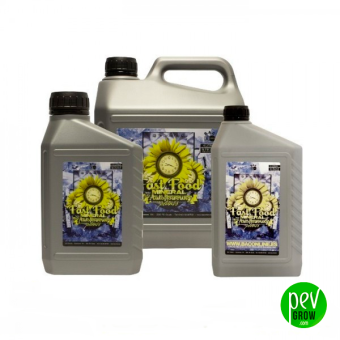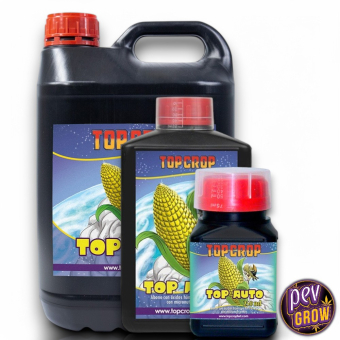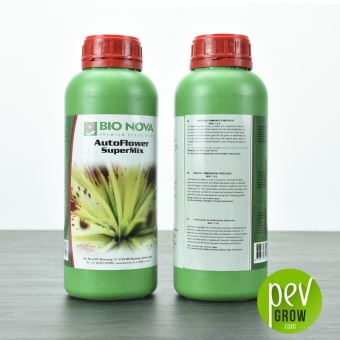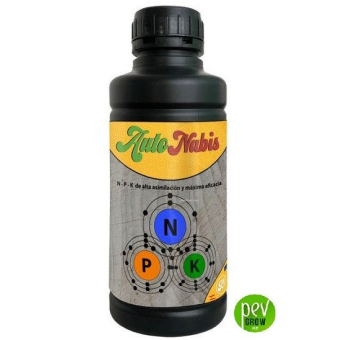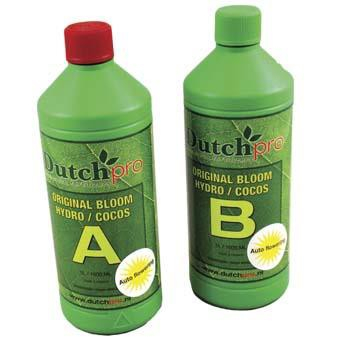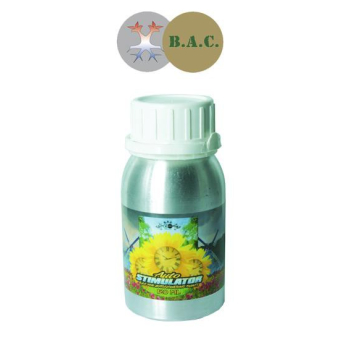- This article addresses the fertilization of autoflowering cannabis plants, highlighting their need for specialized nutrition due to their rapid life cycle. Specific fertilizers such as B.A.C.’s Fast Food and Top Crop’s Top Auto are recommended, suitable for their growth and flowering phases. Tips on dosing and the importance of avoiding over-fertilization are provided, as well as techniques to improve the quality of the harvest, such as the use of stimulators and a proper “flush” before collection.
- Best mineral fertilizers for marijuana plants
- Best organic fertilizers for growing cannabis
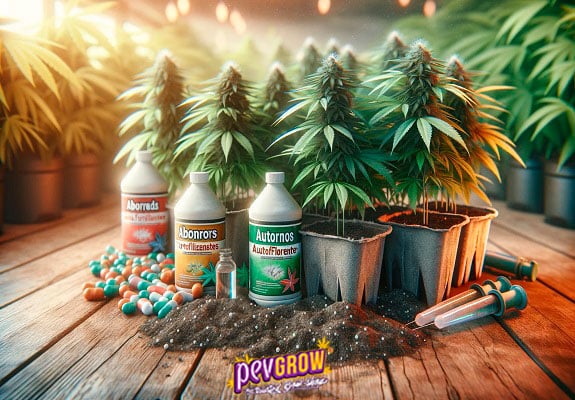

09-02-2024 08:00:00 - Updated: 9 February, 2024
Autoflowering seeds, known for their rapid life cycle and ease of cultivation, require specialized nutrition to reach their full potential. Unlike photoperiodic varieties, autoflowers rapidly transition from vegetative growth to flowering, which implies a unique fertilization strategy. At Pevgrow, we understand the importance of choosing the right fertilizer, which is why we’ve compiled a list of the best nutrients on the market specifically designed for autoflowering plants.
Fast Food by B.A.C.:
This all-in-one fertilizer is ideal for both beginner and experienced growers. Fast Food provides all the necessary nutrients throughout the complete life cycle of the autoflowering plant, facilitating healthy growth and abundant flowering. The best part is that if you prefer quality, you have organic Fast Food available, but if you prioritize yield, you can choose mineral Fast Food.
Top Auto by Top Crop:
Specifically formulated for autoflowers, Top Auto by Top Crop offers a balanced mix of nutrients that promote vigorous development throughout all growth stages. Its composition helps plants to bloom optimally, respecting their natural cycle, as it provides humic and fulvic acids, chelated microelements, and other positive components for the rapid development of autoflowers.
Autoflower SuperMix by Bio Nova:
This fertilizer from Bio Nova is designed to meet the specific needs of autoflowering varieties. Autoflower SuperMix ensures balanced nutrition, supporting both vegetative growth and flowering without the need to switch products. Its seaweed-based composition ensures excellent organoleptic properties of the harvested marijuana.
Autonabis by Terranabis:
Autonabis is an organic option for growers who prefer natural products. This fertilizer stimulates healthy root growth and improves plant resistance, optimizing both growth and flower production.
Autoflowering Grow & Bloom by Dutch Pro:
This fertilizer from Dutch Pro is a complete solution for the life cycle of autoflowering plants grown in hydroponics or coco fiber. With a formula that supports both growth and flowering, Autoflowering Grow & Bloom is ideal for ensuring proper nutrition in all phases.
Auto Stimulator by B.A.C.:
Auto Stimulator by B.A.C. is an additive that enhances nutrient absorption and stimulates the plant’s immune system. Although not a fertilizer itself, it is a perfect complement to enhance the health and performance of your autoflowers, as it stimulates the development of beneficial micro-life that promotes nutrient assimilation by the roots.
Product Table
| Fertilizer | NPK Composition (approximate) | Recommended Dosage | Main Features |
|---|---|---|---|
| Fast Food by B.A.C. | 5-4-8 | 3, 4 or 5 ml/l | All-in-one, easy to use |
| Top Auto by Top Crop | 3.5-5.3-5 | 2.5-3.5 ml/l | Balanced, for all phases |
| Autoflower SuperMix by Bio Nova | 5-2-5 | 2-4 ml/l | Complete nutrition, promotes flowering |
| Autonabis by Terranabis | 3.5-5.3-5 | 1, 2 or 3 ml/l | Organic, stimulates root growth |
| Autoflowering Grow & Bloom by Dutch Pro | 5.3-2.1-5.9 | 2-3 ml/l | Complete solution, growth and flowering |
| Auto Stimulator by B.A.C. | N/A | 1 to 2 ml per every 5 liters of water | Nutrient absorption and defense stimulator |
Fertilizing Autoflowers
Fertilization of autoflowers must be adapted to their rapid vegetative cycle. Unlike photodependent varieties, autoflowers continue their growth while flowering, which requires a careful balance of nutrients. It’s crucial to cut fertilization before the end of their cycle to avoid unwanted flavors and aromas in the harvest. Although these plants are usually resistant to over-fertilization, it’s always preferable to err on the side of caution to not compromise their development.
Autoflower Fertilization: Techniques and Tips for Successful Cultivation
Fertilizing autoflowering plants requires a careful and personalized approach, due to their unique and rapid life cycle. Here we offer you advanced techniques, methods, tips, and tricks to maximize the potential of your autoflowering plants.
1. Understanding the Life Cycle of Autoflowers:
- Autoflowers typically complete their cycle in about 8-10 weeks from germination.
- They do not depend on a change in the light cycle to begin flowering.
- They require a balance of nutrients that supports both vegetative growth and flowering.
2. Fertilization During the Vegetative Growth Phase:
- Start with lighter fertilization to avoid the risk of over-fertilization in the early stages.
- Use a fertilizer with a higher concentration of nitrogen to promote healthy and robust growth of stems and leaves.
3. Transition to the Flowering Phase:
- Gradually reduce nitrogen and increase nutrients such as phosphorus and potassium, which are essential for flower development.
- Watch the plant’s signals closely to adjust nutrients as needed.
4. Fertilization Techniques:
- “Feed-Water-Feed”: Alternate watering with and without nutrients to prevent salt buildup in the substrate.
- Foliar Fertilization: Use light sprays on the leaves for a quick supply of micronutrients (Only until buds are present)
5. Tips for Using Fertilizers:
- Always dilute fertilizers according to the manufacturer’s instructions to avoid burning the plants.
- Consider using organic fertilizers to promote healthy soil microbiology.
6. Beware of Over-Fertilization:
- Autoflowers are less tolerant of over-fertilization than photoperiodic plants.
- Watch for signs such as yellow or burned leaf tips, and reduce the dose if necessary.
7. Cutting Fertilization before Harvest:
- Reduce and eventually stop fertilization about two weeks before harvest to improve the taste and quality of the flowers.
- If applicable, perform a root flush to remove any remaining fertilizer residues.
8. Tricks for Optimal Cultivation:
- Autoflowers fix more nitrogen in the leaves than photoperiodic plants, keep this in mind.
- pH Monitoring: Maintain an adequate pH in your irrigation solution to ensure nutrient availability.
9. Use of Stimulators and Additives:
- Consider additives like enzymes or root stimulators to improve nutrient absorption and overall plant health.
- It is highly recommended to add beneficial micro-life in the substrate and the first waterings.
10. Autoflower Fertilization Checklist:
- Start with light fertilization and increase gradually.
- Adjust nutrients according to the growth stage.
- Monitor the plant and substrate for timely adjustments.
- Perform a “flush” before harvest.
- Keep a record of your fertilization practices for adjustments in future crops.
Conclusion:
Choosing the right fertilizer for your autoflowering plants is crucial for their success. With options ranging from all-in-one solutions to specific stimulators, growers can find the perfect product for their needs at Pevgrow. Always remember to adjust your fertilization strategy to the unique cycle of these plants for the best results.
FAQs:
- Can I use the same fertilizer for autoflowers as for photodependent plants? Although possible, it’s ideal to use specific fertilizers for autoflowers, as they are formulated to suit their rapid life cycle.
- How often should I fertilize my autoflowering plants? It depends on the fertilizer you choose, but it’s generally recommended to follow the manufacturer’s instructions and closely observe the plant’s response. I personally prefer one watering with fertilizer followed by another with water only.
- Is it necessary to change fertilizers during the life cycle of an autoflower? Some fertilizers are designed for use throughout the entire cycle, while others require switching from a growth product to a flowering one.
- How do I know if I’m over-fertilizing my autoflowering plants? Signs of over-fertilization include burned leaf tips, leaf drop, and slow growth. It’s important to act quickly to correct the problem.
- What do I do if my autoflowering plant shows signs of nutritional deficiency? Make sure you’re using an appropriate fertilizer in the correct amount. If the problem persists, consider adjusting the soil or irrigation water pH.


